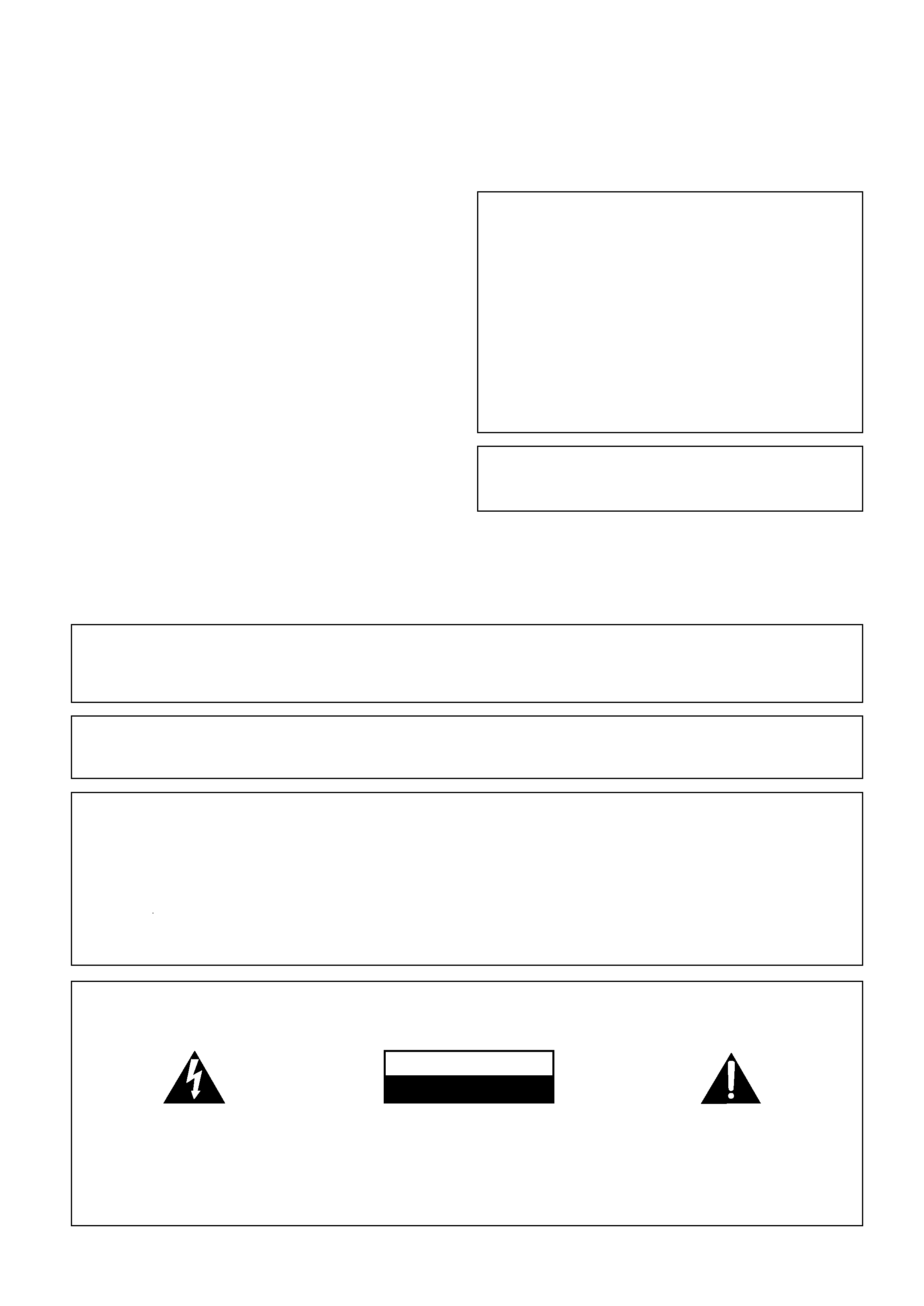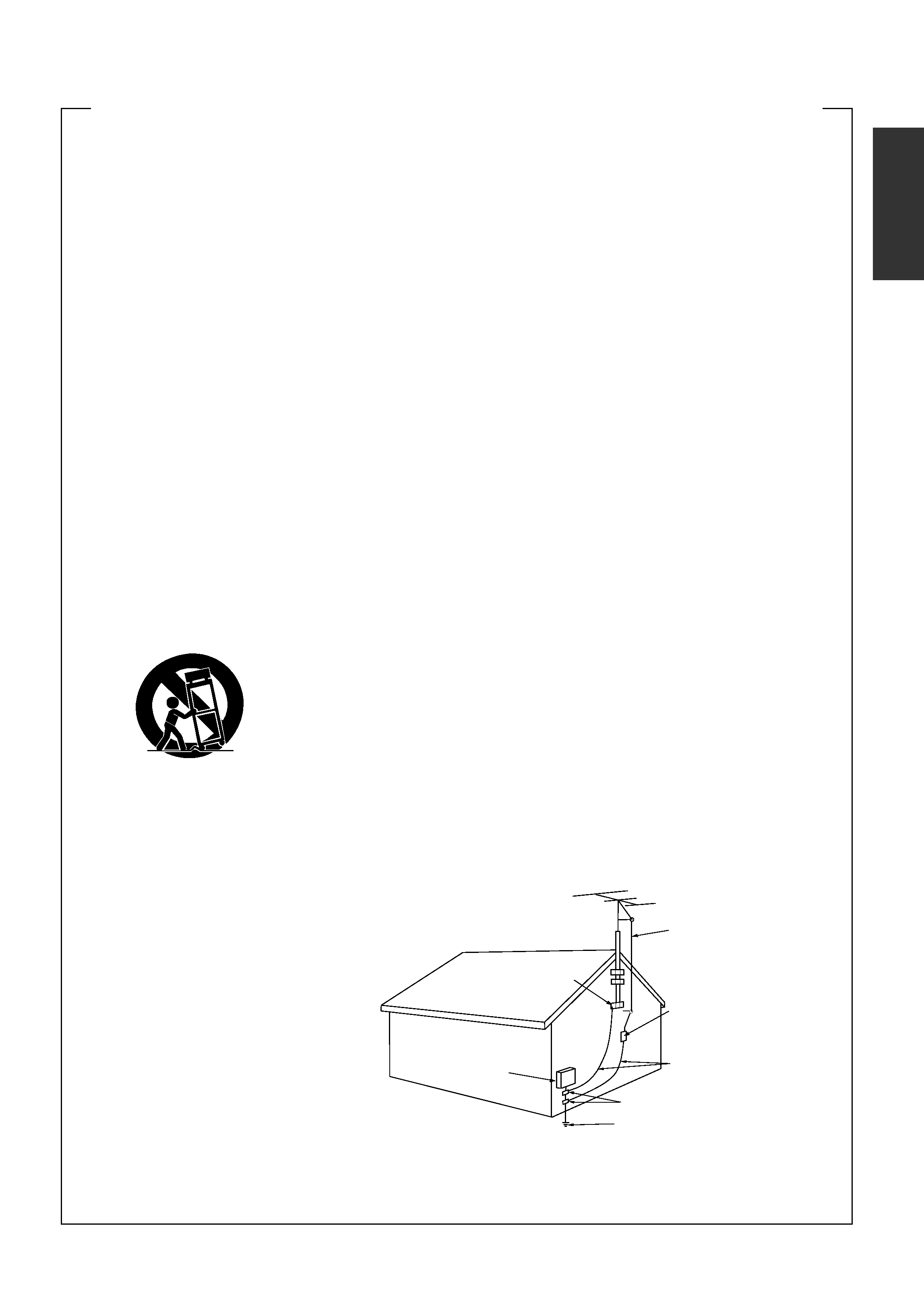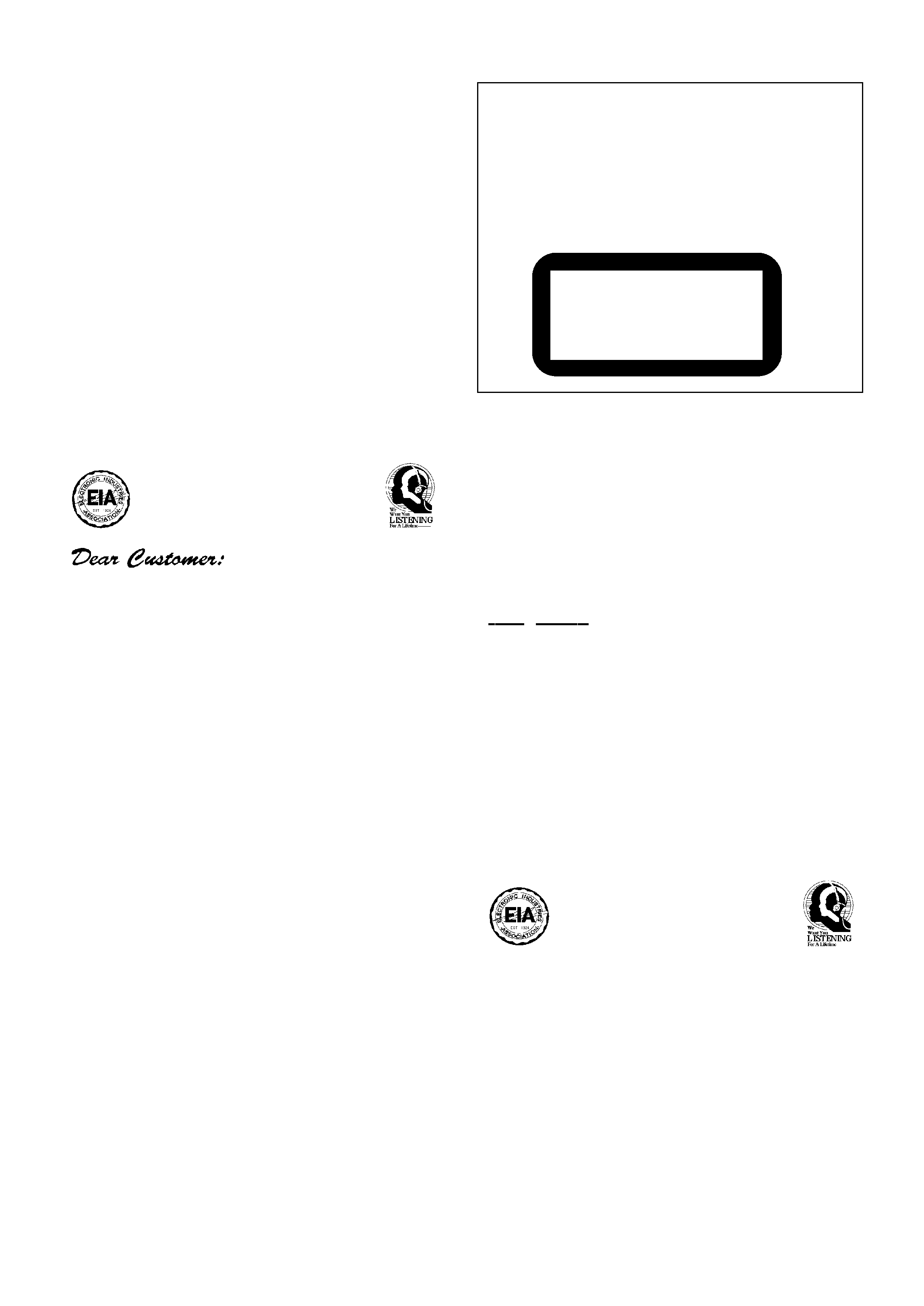
Operating Instructions
Mode d'emploi
STEREO DVD CASSETTE DECK RECEIVER
AMPLI-TUNER /LECTEUR/DVD
DOUBLE PLATINE A CASSETTE
XR-A9700DV
XR-VS100D
S-A9700V
S-VS100V
SPEAKER SYSTEM
ENCEINTES ACOUSTIQUES

WARNING: TO PREVENT FIRE OR SHOCK
HAZARD, DO NOT EXPOSE THIS APPLIANCE TO
RAIN OR MOISTURE.
IMPORTANT NOTICE
[For U.S. model]
The serial number for this equipment is located on the
rear panel. Please write this serial number on your
enclosed warranty card and keep it in a secure area. This
is for your security.
[For Canadian model]
CAUTION: TO PREVENT ELECTRIC SHOCK DO
NOT USE THIS (POLARIZED) PLUG WITH AN
EXTENSION CORD, RECEPTACLE OR OTHER
OUTLET UNLESS THE BLADES CAN BE FULLY
INSERTED TO PREVENT BLADE EXPOSURE.
The exclamation point within an equilateral
triangle is intended to alert the user to the
presence of important operating and
maintenance (servicing) instructions in the
literature accompanying the appliance.
CAUTION:
TO PREVENT THE RISK OF ELECTRIC SHOCK, DO
NOT REMOVE COVER (OR BACK).
NO USER-
SERVICEABLE PARTS INSIDE. REFER SERVICING
TO QUALIFIED SERVICE PERSONNEL.
The lightning flash with arrowhead symbol, within
an equilateral triangle, is intended to alert the user
to the presence of uninsulated "dangerous voltage"
within the product's enclosure that may be of
sufficient magnitude to constitute a risk of electric
shock to persons.
IMPORTANT
RISK OF ELECTRIC SHOCK
DO NOT OPEN
CAUTION
Demo Function
The demo function is intended primarily for store
displays and shows off the various features of the
unit. The unit goes into demo mode automatically
after plugging the unit in. The demo mode stops
when either the STANDBY/ON button or one of the
function buttons is pressed.
To switch the demo mode off completely, press the
P
.BASS (DEMO) button for more than 3 seconds while
in standby mode. Follow the same procedure if you
want to swith the demo mode on again at any time.
[For Canadian model]
This Class B digital apparatus complies with Canadian
ICES-003.
Information to User
Alteration or modifications carried out without appropriate authorization may invalidate the user's right to operate the
equipment.
[FOR U.S. MODEL]
CAUTION
· Use of controls or adjustments or performance of procedures other than those specified herein may result in hazardous radiation exposure.
· The use of optical instruments with this product will increase eye hazard.
This equipment has been tested and found to comply with the limits for a Class B digital device, pursuant to Part 15 of the FCC Rules.
These limits are designed to provide reasonable protection against harmful interference in a residential installation. This equipment
generates, uses, and can radiate radio frequency energy and, if not installed and used in accordance with the instructions, may cause
harmful interference to radio communications. However, there is no guarantee that interference will not occur in a particular installation.
If this equipment does cause harmful interference to radio or television reception, which can be determined by turning the equipment
off and on, the user is encouraged to try to correct the interference by one or more of the following measures:
Reorient or relocate the receiving antenna.
Increase the separation between the equipment and receiver.
Connect the equipment into an outlet on a circuit different from that to which the receiver is connected.
Consult the dealer or an experienced radio/TV technician for help.
Thank you for buying this Pioneer product.
Please read through these operating instructions so you will know how to operate your model properly. After you
have finished reading the instructions, put them away in a safe place for future reference.
In some countries or regions, the shape of the power plug and power outlet may differ from that shown in the
explanatory drawings. However, the method of connecting and operating the unit is the same.
THE STANDBY/ON BUTTON IS SECONDARY CONNECTED
AND THEREFORE DOES NOT SEPARATE THE UNIT FROM
MAINS POWER IN STANDBY POSITION.

READ INSTRUCTIONS -- All the safety and
operating instructions should be read before
the product is operated.
RETAIN INSTRUCTIONS -- The safety and
operating instructions should be retained for
future reference.
HEED WARNINGS -- All warnings on the product
and in the operating instructions should be
adhered to.
FOLLOW INSTRUCTIONS -- All operating and
use instructions should be followed.
CLEANING -- Unplug this product from the wall
outlet before cleaning. The product should be
cleaned only with a polishing cloth or a soft dry
cloth. Never clean with furniture wax, benzine,
insecticides or other volatile liquids since they
may corrode the cabinet.
ATTACHMENTS -- Do not use attachments not
recommended by the product manufacturer as
they may cause hazards.
WATER AND MOISTURE -- Do not use this
product near water -- for example, near a
bathtub, wash bowl, kitchen sink, or laundry
tub; in a wet basement; or near a swimming
pool; and the like.
ACCESSORIES -- Do not place this product on an
unstable cart, stand, tripod, bracket, or table.
The product may fall, causing serious injury to
a child or adult, and serious damage to the
product. Use only with a cart, stand, tripod,
bracket, or table recommended by the
manufacturer, or sold with the product. Any
mounting of the product should follow the
manufacturer's instructions, and should use a
mounting accessory recommended by the
manufacturer.
CART -- A product and cart combination should be
moved with care. Quick stops, excessive force,
and uneven surfaces may cause the product
and cart combination to overturn.
IMPORTANT SAFETY INSTRUCTIONS
VENTILATION -- Slots and openings in the cabinet
are provided for ventilation and to ensure reliable
operation of the product and to protect it from
overheating, and these openings must not be
blocked or covered. The openings should never
be blocked by placing the product on a bed, sofa,
rug, or other similar surface. This product should
not be placed in a built-in installation such as a
bookcase or rack unless proper ventilation is
provided or the manufacturer's instructions have
been adhered to.
POWER SOURCES -- This product should be
operated only from the type of power source
indicated on the marking label. If you are not
sure of the type of power supply to your home,
consult your product dealer or local power
company.
LOCATION The appliance should be installed
in a stable location.
NONUSE PERIODS The power cord of the
appliance should be unplugged from the
outlet when left un-used for a long period of
time.
GROUNDING OR POLARIZATION
÷
If this product is equipped with a polarized
alternating current line plug (a plug having one
blade wider than the other), it will fit into the outlet
only one way. This is a safety feature. If you are
unable to insert the plug fully into the outlet, try
reversing the plug. If the plug should still fail to fit,
contact your electrician to replace your obsolete
outlet. Do not defeat the safety purpose of the
polarized plug.
÷
If this product is equipped with a three-wire
grounding type plug, a plug having a third
(grounding) pin, it will only fit into a grounding type
power outlet. This is a safety feature. If you are
unable to insert the plug into the outlet, contact
your electrician to replace your obsolete outlet.
Do not defeat the safety purpose of the grounding
type plug.
POWER-CORD PROTECTION -- Power-supply cords
should be routed so that they are not likely to be
walked on or pinched by items placed upon or
against them, paying particular attention to cords
at plugs, convenience receptacles, and the point
where they exit from the product.
OUTDOOR ANTENNA GROUNDING -- If an outside
antenna or cable system is connected to the
product, be sure the antenna or cable system is
grounded so as to provide some protection against
voltage surges and built-up static charges. Article
810 of the National Electrical Code, ANSI/NFPA
70, provides information with regard to proper
grounding of the mast and supporting structure,
grounding of the lead-in wire to an antenna
discharge unit, size of grounding conductors,
location of antenna-discharge unit, connection to
grounding electrodes, and requirements for the
grounding electrode. See Figure A.
LIGHTNING -- For added protection for this product
during a lightning storm, or when it is left
unattended and unused for long periods of time,
unplug it from the wall outlet and disconnect the
antenna or cable system. This will prevent damage
to the product due to lightning and power-line
surges.
POWER LINES -- An outside antenna system should
not be located in the vicinity of overhead power
lines or other electric light or power circuits, or
where it can fall into such power lines or circuits.
When installing an outside antenna system,
extreme care should be taken to keep from
touching such power lines or circuits as contact
with them might be fatal.
OVERLOADING -- Do not overload wall outlets,
extension cords, or integral convenience
receptacles as this can result in a risk of fire or
electric shock.
OBJECT AND LIQUID ENTRY -- Never push
objects of any kind into this product through
openings as they may touch dangerous voltage
points or short-out parts that could result in a
fire or electric shock. Never spill liquid of any
kind on the product.
SERVICING -- Do not attempt to service this
product yourself as opening or removing covers
may expose you to dangerous voltage or other
hazards. Refer all servicing to qualified service
personnel.
DAMAGE REQUIRING SERVICE -- Unplug this
product from the wall outlet and refer servicing
to qualified service personnel under the
following conditions:
÷
When the power-supply cord or plug is
damaged.
÷
If liquid has been spilled, or objects have fallen
into the product.
÷
If the product has been exposed to rain or
water.
÷
If the product does not operate normally by
following the operating instructions. Adjust only
those controls that are covered by the operating
instructions as an improper adjustment of other
controls may result in damage and will often
require extensive work by a qualified technician
to restore the product to its normal operation.
÷
If the product has been dropped or damaged in
any way.
÷
When the product exhibits a distinct change in
performance -- this indicates a need for service.
REPLACEMENT PARTS -- When replacement
parts are required, be sure the service technician
has used replacement parts specified by the
manufacturer or have the same characteristics
as the original part. Unauthorized substitutions
may result in fire, electric shock, or other
hazards.
SAFETY CHECK -- Upon completion of any service
or repairs to this product, ask the service
technician to perform safety checks to
determine that the product is in proper operating
condition.
WALL OR CEILING MOUNTING -- The product
should not be mounted to a wall or ceiling.
HEAT -- The product should be situated away from
heat sources such as radiators, heat registers,
stoves, or other products (including amplifiers)
that produce heat.
ANTENNA
LEAD IN
WIRE
GROUND
CLAMP
ANTENNA
DISCHARGE UNIT
(NEC SECTION 810-20)
GROUNDING CONDUCTORS
(NEC SECTION 810-21)
GROUND CLAMPS
POWER SERVICE GROUNDING
ELECTRODE SYSTEM
(NEC ART 250, PART H)
ELECTRIC
SERVICE
EQUIPMENT
NEC -- NATIONAL ELECTRICAL CODE
Fig. A
English

Selecting fine audio equipment such as the unit you've just purchased is
only the start of your musical enjoyment. Now it's time to consider how you
can maximize the fun and excitement your equipment offers. This manu-
facturer and the Electronic Industries Association's Consumer Electronics
Group want you to get the most out of your equipment by playing it at a safe
level. One that lets the sound come through loud and clear without
annoying blaring or distortion-and, most importantly, without affecting
your sensitive hearing.
Sound can be deceiving. Over time your hearing "comfort level" adapts
to higher volumes of sound. So what sounds "normal" can actually be loud
and harmful to your hearing. Guard against this by setting your equipment
at a safe level BEFORE your hearing adapts.
To establish a safe level:
÷ Start your volume control at a low setting.
÷ Slowly increase the sound until you can hear it comfortably and
clearly, and without distortion.
Once you have established a comfortable sound level:
÷ Set the dial and leave it there.
Taking a minute to do this now will help to prevent hearing damage or
loss in the future. After all, we want you listening for a lifetime.
We Want You Listening For A Lifetime
Used wisely, your new sound equipment will provide a lifetime of fun
and enjoyment. Since hearing damage from loud noise is often undetect-
able until it is too late, this manufacturer and the Electronic Industries
Association's Consumer Electronics Group recommend you avoid pro-
longed exposure to excessive noise. This list of sound levels is included for
your protection.
Information courtesy of the Deafness Research Foundation.
90
Subway, motorcycle, truck traffic, lawn mower
100
Garbage truck, chain saw, pneumatic drill
120
Rock band concert in front of speakers, thunderclap
140
Gunshot blast, jet plane
180
Rocket launching pad
THE FOLLOWING NOISES CAN BE DANGEROUS UNDER
CONSTANT EXPOSURE
30
Quiet library, soft whispers
40
Living room, refrigerator, bedroom away from traffic
50
Light traffic, normal conversation, quiet office
60
Air conditioner at 20 feet, sewing machine
70
Vacuum cleaner, hair dryer, noisy restaurant
80
Average city traffic, garbage disposals, alarm clock
at two feet.
Decibel
Level
Example
[For Australian model]
CAUTION
This product contains a laser diode of higher class than 1.
To ensure continued safety, do not remove any covers
or attempt to gain access to the inside of the product.
Refer all servicing to qualified personnel.
The following caution label appears on your unit.
Location: rear of the unit
Energy-saving design
This system is designed to use less than 1W of electric-
ity when power is switched to Standby.
Regarding the exact value of the Power Consumption
in standby mode, refer to specifications on page 59.
POWER-CORD CAUTION
Handle the power cord by the plug. Do not pull out the
plug by tugging the cord and never touch the power
cord when your hands are wet as this could cause a
short circuit or electric shock. Do not place the unit, a
piece of furniture, etc., on the power cord, or pinch the
cord. Never make a knot in the cord or tie it with other
cords. The power cords should be routed such that
they are not likely to be stepped on. A damaged power
cord can cause a fire or give you an electrical shock.
Check the power cord once in a while. When you find
it damaged, ask your nearest PIONEER authorized
service center or your dealer for a replacement.
CLASS 1
LASER PRODUCT

Contents
1 Before You Start
Checking what's in the box ......................................... 6
Putting the batteries in the remote ............................. 6
Using the remote control ............................................. 6
Finding a suitable location ......................................... 7
Avoiding condensation problems ................................ 7
Handling discs ............................................................. 8
Storing discs ................................................................. 8
Discs to avoid ............................................................... 8
Using cassette tapes ..................................................... 8
Erase protection ........................................................... 8
2 Connecting up
Understanding the Rear Panel ..................................... 9
Connecting the Speakers ............................................... 9
Connecting to Your TV ................................................ 10
Setting the TV format ................................................ 11
Connecting the Radio Antennas ................................. 11
Connecting Auxiliary Components ............................. 12
Connecting an external AV amplifier ........................ 12
Connecting the Power ................................................. 12
3 Controls and Displays
Front Panel Controls ................................................... 13
Disc and amplifier section ......................................... 13
Tuner and tape deck section ...................................... 14
Display ......................................................................... 15
Remote Control Unit ................................................... 16
Switching On and Setting the Clock ........................... 18
4 Getting Started
A Disc Primer ............................................................... 19
Surround sound modes ............................................. 19
TV screen formats ...................................................... 19
Titles, chapters and tracks ......................................... 19
Multilingual discs ...................................................... 19
Menu language .......................................................... 19
DVD Regions .............................................................. 20
DVD video copy protection ......................................... 20
Video CD PBC mode ................................................... 20
Disc and player restrictions ....................................... 20
Setting Up Using the Setup Navigator ........................ 21
Playing Discs ............................................................... 23
Watching a DVD disc ................................................. 23
Watching a Video CD disc .......................................... 24
Playing an audio CD ................................................. 25
Freeze-frame, frame advance and slow-motion ....... 26
Accessing tracks directly ............................................ 27
Using Dolby Virtual ..................................................... 27
Using the On-screen Menus ........................................ 28
Basic and Expert setup menus .................................. 29
Changing the OSD menu language .......................... 29
Player menus and disc menus .................................. 29
5 Watching Multilingual DVD Discs
Switching Languages on Playback ............................. 30
Switching audio language during playback ............. 30
Selecting subtitle language during playback ........... 30
Setting Language Preferences ..................................... 30
Setting your preferred audio language ..................... 31
Setting your preferred subtitle language................... 31
Setting subtitle display preferences ........................... 31
Changing default subtitles ........................................ 32
Switching off Auto Language .................................... 32
Selecting the disc menu language ............................ 32
Language Code List ..................................................... 33
6 More Disc Functions
Playing Tracks at Random ......................................... 34
Repeating Tracks ......................................................... 34
Programming the Track Order ................................... 35
Displaying Disc Information ...................................... 37
Resuming Playback (Last Memo function) ............... 37
Changing Camera Angles ........................................... 38
Changing the Picture Quality ..................................... 39
Restricting Access to Discs ........................................... 39
Playing locked discs ................................................... 40
Changing your password ........................................... 40
Setting Preferences for a Disc ...................................... 40
Clearing memorized settings ..................................... 40
7 Sound and Picture Settings
Listening at Low Volume ............................................. 41
Changing the Sound Output Settings ......................... 41
Miscellaneous Settings ................................................ 42
Changing the still frame ........................................... 42
Hiding the on-screen messages ................................. 42
Setting the on-screen display position ...................... 42
Setting the OSD background color ............................ 42
8 Using the Tuner
Tuning in Stations ....................................................... 43
Improving poor FM reception ................................... 43
Changing the frequency step ..................................... 43
Memorizing Stations for Quick Recall ....................... 44
Listening to memorized stations ............................... 44
9 Using the Tape Deck
Playing Cassette Tapes ................................................ 45
Using Dolby NR. ........................................................ 46
Resetting the tape counter ......................................... 46
Relay play .................................................................. 47
Making Tape Recordings ............................................ 47
Automatically recording a CD ................................... 48
Copying tapes ............................................................. 49
Improving AM tape recordings .................................. 49
10 Using Sound Modes
Using the Sound Morph .............................................. 50
Memorizing your own settings .................................. 51
Changing the sound display ...................................... 51
11 Using the Timer
Setting the Wake-up Timer ......................................... 52
Setting the Sleep Timer ............................................... 53
Setting the Record Timer ............................................ 53
Canceling the Timer ................................................... 54
12 Additional Information
Troubleshooting .......................................................... 55
Screen format/TV settings ......................................... 57
Resetting all DVD Settings ........................................... 57
Terms ........................................................................... 58
Specifications .............................................................. 59
English
